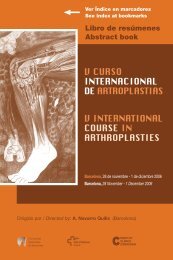Notas / Notes - Active Congress.......
Notas / Notes - Active Congress.......
Notas / Notes - Active Congress.......
You also want an ePaper? Increase the reach of your titles
YUMPU automatically turns print PDFs into web optimized ePapers that Google loves.
VIERNES / FRIDAY<br />
196<br />
knee designs have as a goal the restoration of knee motion<br />
to the maximum achievable by each patient. Those patients<br />
who can achieve motion greater than 135 degrees can benefit<br />
from the “ high flexion” knees. The key to obtaining optimum<br />
knee flexion is designing the articular surface geometry so<br />
that femoral roll back is achieved with either a retained posterior<br />
cruciate ligament or a ligament substituting cam mechanism.<br />
Optimization of the articular surface position is more critical<br />
for the retained cruciate design. Once the anterior/posterior<br />
curvature of the articular surface and its location is optimized,<br />
the knee joint’s wear rate may be minimized by choosing appropriate<br />
medial/lateral radii of curvature. An additional design<br />
requirement for joint surface curvature is to balance knee joint<br />
laxity against knee joint stability. The choice of materials also<br />
has a major impact on minimizing joint wear.<br />
WEAR ANALYSIS OF RETRIEVED<br />
UHMWPE TIBIAL COMPONENTS FROM<br />
ROTATING PLATFORM TOTAL KNEE<br />
REPLACEMENTS<br />
Victor M. Goldberg, M.D; Ryan Garcia, M.D;<br />
Matthew Kraay, M.D; Clare Rinmac, Ph.D.<br />
Case Medical Center, Department of Orthopaedics<br />
Cleveland, Ohio (USA)<br />
Mobile-bearing total knee replacements (TKRs) were designed<br />
to increase conformity, decrease contact stresses, and decrease<br />
polyethylene damage. Our objective was to evaluate the<br />
performance of retrieved mobile-bearing TKRs with respect<br />
to wear damage of the polyethylene in a series of components<br />
obtained at revision surgery. Tibial component polyethylene<br />
superior and inferior surface damage and radiographic radiolucency<br />
analysis was conducted on 40 retrieved mobile-bearing<br />
TKRs. Higher levels of superior articulating surface damage<br />
were found to be associated with higher levels of inferior surface<br />
damage in this retrieval study. Greater levels of damage<br />
were present on both surfaces in components with greater<br />
radiographic radiolucency scores and mechanically loose component.<br />
The mobile bearing TKR remains vulnerable to polyethylene<br />
wear damage at the superior surface and introduced<br />
an independent inferior surface also vulnerable to wear damage.<br />
MOBILE BEARINGS:<br />
ARE THEY WORTH IT?<br />
Peter Bonutti, MD<br />
Bonutti Clinic. Effingham, Illinois (USA)<br />
Mobile Bearing is a technology which adds additional cost<br />
to Knee Arthroplasty. Are there added clinical benefits to justify<br />
this cost? Numerous factors have been suggested to add<br />
clinical value in MB TKA. However, a critical review of clinical<br />
data may not support this. Alleged clinical benefits for MB<br />
TKA include: 1) “The only knee that bends and rotates” -<br />
False. 2) Improved function - Not accurate. 3) Improved ROM<br />
- False. 4) Improved long term survivorship - unproven. 5)<br />
Reduced polyethylene wear - not proven in in vivo studies.<br />
6) Improved patellofemoral tracking - inaccurate. 7) “Surgical<br />
forgiveness” - actually more challenging. In addition, MB TKA<br />
may have additional complications not found in fixed bearings<br />
such as bearing subluxations, dislocations, and insert fractures.<br />
Two recent clinical studies, Ball et al (2006) and Delport et<br />
al (2006), have suggested possible functional benefit in<br />
flexion and stair climbing, but these may be design or<br />
technique specific.<br />
MB TKA theoretical advantages possibly may be design or<br />
technique specific, but the majority of clinical literature does<br />
not prove benefit associated with MB TKA and there is published<br />
technical complexity and risk. Based on current review<br />
MB TKA is not worth the additional cost.<br />
HIGH FLEXION, ROTATING PLATFORM<br />
TOTAL KNEE ARTHROPLASTY:<br />
SCIENTIFIC BASIS AND CLINICAL<br />
EXPERIENCE<br />
Richard “Dickey” Jones, M.D.<br />
U.T. Shoutwestern Medical Center.<br />
Dallas, Texas, (USA)<br />
High flexion in TKA is any flexion beyond 125°. High flexion<br />
lifestyle activities such as kneeling or praying are done with<br />
internal rotation, external rotation, and in neutral. Therefore,<br />
maximum flexion TKA requires a rotating platform. Superior<br />
range of motion and fluoroscopic kinematics of femoral rollback<br />
have been shown with the Sigma RP posterior stabilized<br />
knee. This knee was modified to produce the Sigma RP-F,<br />
a maximum flexion knee, by adding a third contact area at<br />
the post-cam mechanism to significantly increase bearing<br />
conformity and decrease poly stresses in the range of 125-<br />
155. Clinical experience is reported with statistically significant<br />
increase in postoperative range of motion in patients with the<br />
Sigma RP-F. Patient selection criteria for the Sigma RP-F<br />
include patients with high flexion lifestyle, younger, more active<br />
patients demanding a better ROM, and those patients<br />
with less than 100° preoperative ROM. This knee system<br />
shows significant promise in providing maximum flexion and<br />
system longevity is expected.





